West Is Best
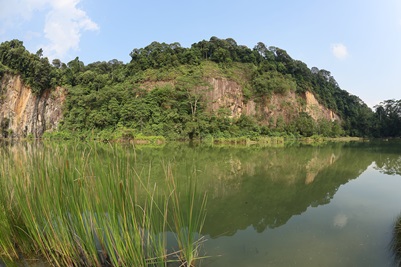
Hindhede Nature Park
Singapore’s west may be historically known for its industrial estate as well as the sites for our universities, but today, it is also home to a variety of gardens and nature parks.
The verdant greenery of Zhenghua, Hindhede, Dairy Farm and Bukit Batok Nature Park, combined with the 53-ha Lakeside Garden, situated in the western section of Jurong Lake Gardens and the various park connectors in the area are the sites of nature-based activities and experiences everyone can enjoy.
Read on to find out how to spend your free time enjoying a variety of activities amidst nature in this side of our island.
Spot Birds in Action
Singapore is home to a vibrant, diverse range of feathered friends, and there are many places in the West where you can spot some of them.
One such location is Zhenghua Nature Park. As a green buffer skirting the Central Catchment Nature Reserve, it is a haven for bird-watchers, as at least 37 bird species have been spotted here, including the Flameback Woodpecker (Dinopium javanense), Long-tailed Parakeet (Psittacula longicauda) and Pink-necked Green Pigeon (Treron vernans).
-(compressed).jpg?h=267&w=401)
Photo credit: Benjamin Tan
The male Flameback Woodpecker is easy to spot with is bright red crown and crest. The female has a black brown streaked with white. Both have golden-yellow mantle and wing lining with white underparts with black-laced scales and red rump.
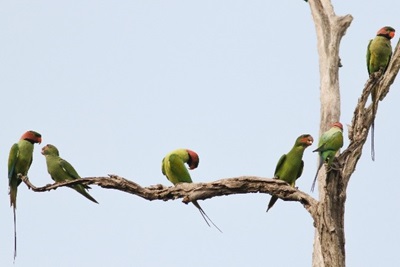
Photo credit: Teo Chee Kee
The Long-tailed Parakeet is Singapore’s only native parakeet. The male has a bright red bill, pink face, dark green crown, black moustache, and light green underparts while the female is duller with light pink cheeks and a black bill.
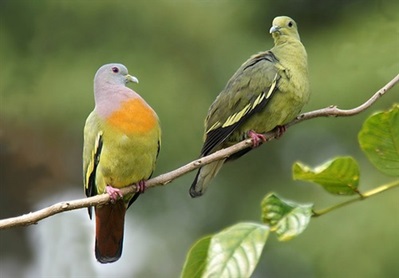
Photo credit: Cai Yixiong
The male Pink-necked Green Pigeon is another easy-to-spot bird, with its distinctly coloured grey face and throat, light purple neck and breast, orange lower breast and light green belly. The female is uniformly green. Both the male and female are involved in the incubation of eggs and care of young chicks.
Another good location for bird-watching is Hindhede Nature Park. Located next to Bukit Timah Nature Reserve, this was once a granite quarry but now features green spaces, hiking trails, and beautiful quarry views. These features combined make it a perfect place to spot birds. Among those that have been seen include the sleek Black bittern (Dupetor flavicollis) and White-throated kingfisher (Halcyon smyrnensis).
.jpg?h=350&w=234)
Photo credit: Francis Yap
At about 55 cm in height, the Black Bittern has black ear coverts, upperparts, legs and feet, with a long dagger-like yellow bill with a dark tip. It lacks a head crest with a white throat and breast, with broad black streaks and plain buff patch on the sides of its neck and upper breast.

The White-throated Kingfisher gets its name from the obvious white patch on its throat that can extend down to its breast. It grows up to 28 cm, making it one of the bigger kingfisher species found locally. In addition to fish, it also preys on large insects and small animals.
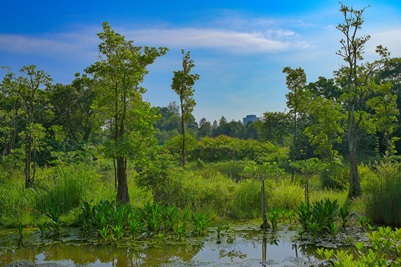
Alstonia Island at Jurong Lake Gardens
Another insta-worthy spot is at Jurong Lake Gardens which features the man-made Alstonia Island that visitors can observe from a boardwalk. It is surrounded by a freshwater swamp habitat designed to reflect the natural history of the area before Jurong was developed. The landscape consists of tranquil waters reflecting the tall yet thin mottled trunks of the Alstonia spatulata, or Marsh Pulai, after which the island was named.

Photo credit: Lim Chien Hin
Be sure to look skywards while in Jurong. While rarely encountered elsewhere, the Grey-headed Fish Eagle (Haliaeetus ichthyaetus) can be found around Jurong Lake, the large water body in the heart of Jurong Lake Gardens. The eagle perches from vantage points such as bare branches overlooking the water. When it spots a fish or waterbird, it swoops down to glide along the water surface and grabs its prey with its powerful talons.
Learn About our Biodiversity
Supplement your appreciation of nature by learning more about our flora and fauna.
Perfect for people and families of all ages, Dairy Farm Nature Park features the Wallace Trail and Wallace Education Centre that share information about our local biodiversity with visitors. These new features are named for the famed naturalist Alfred Russel Wallace, who journeyed around the Malay Archipelago in the mid-1800s to collect samples of flora and fauna. Did you know that he collected about 700 species of beetles from the Dairy Farm site?
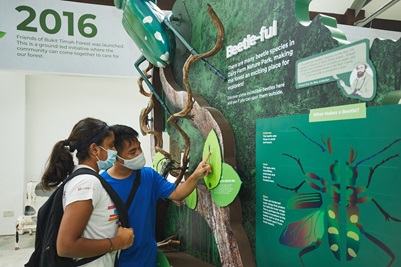
Wallace Education Centre
The Wallace Education Centre was formerly a cow shed, but it now features interactive exhibits where visitors can learn about the rich biodiversity and biogeography of Singapore. There is even a Citizen Science Centre where you can use microscopes and magnifying glasses to observe specimens up close.
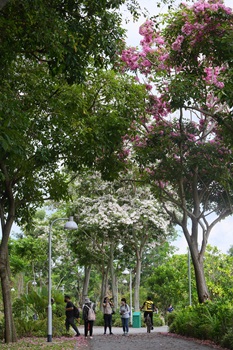
Jurong Lake Gardens
If you are up for a leisurely stroll, why not spend the time on the Biodiversity Guided Walks and Sunset Walks held at Jurong Lake Gardens?
The monthly Biodiversity Guided Walks are a great way to learn more from a guide about how our parks and green spaces are teeming with more life than a passer-by might expect. It is a fun and accessible way to introduce yourself to the biodiversity of the area.
Sunset Walks are another way to meet like-minded nature lovers who want to take a slow walk through the gardens with an informed guide, to learn more about the flora, fauna, and history of the environment.
A Good Workout
There’s nothing like a brisk walk or an adventurous bike ride through nature.
Breathe in the crisp fresh air at Zhenghua Nature Park as you cycle leisurely along the tarmac footpath. Children are welcome to exert themselves at the rugged-themed playground with an expansive sandbox for imaginative play.
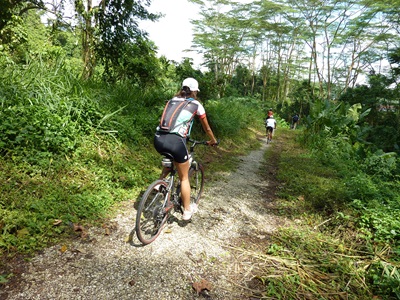
Mountain biking at Dairy Farm Nature Park
If you desire more of an adventure, this park also features undulated terrain for mountainous biking. Similarly, the Bukit Timah Mountain Bike Trail located at Dairy Farm Nature Park, is a designated trail for mountain biking enthusiasts. For everyone’s safety, hikers, walkers, joggers and other visitors not engaged in mountain biking activities, are not permitted to use these bike trails and should keep to the many designated hiking trails instead.
To enjoy a more scenic ride, cycle along the park connectors that criss-cross the area. Bukit Panjang, Pang Sua and Hillview Park Connectors make for good exploration, be it on wheels or on your feet.

Look out for the Black-naped Oriole (Oriolus chinensisi), an unmistakeable garden bird that has a vibrant bright-yellow plumage, broad black mask and nape, and pinkish bill. During the breeding season, it is known to snatch unguarded chicks from the nests of smaller birds to feed to their own young!

Photo credit: Lawrence Chia
A smaller, but no less striking bird to spot along the park connectors is the Olive-backed Sunbird (Cinnyris jugularis). Mainly nectivorous and insectivorous, it feeds mostly on nectar and also captures insects for its young. Both the male and female have a dull olive brown back with yellow underparts, but the male also has a metallic blue forehead, throat, and upper breast.
What Are Nature Parks?
Most of us are familiar with our four nature reserves – Bukit Timah, Central Catchment, Labrador and Sungei Buloh Wetland Reserve. They safeguard primary and secondary rainforests and are core habitats for precious native biodiversity. And by being primary providers of ecosystem services, they also help supply us with clean air and water.
Buffering these nature reserves are more than 350 ha of forested areas known as nature parks. Besides extending Singapore’s natural capital, these parks serve as complementary habitats and buffers to protect the nature reserves against the impact of urbanisation and human activities. They also provide expanded habitats for Singapore’s native flora and fauna, to thrive beyond the nature reserves.
Learning More About Our City in Nature
Over the years, NParks has created a green network comprising roadside planting and a Park Connector Network that links up parks and other green spaces. Skyrise greenery dot developments while biophilic design has been adopted in restoring habitats.
But as Singapore continues to urbanise, the growing infrastructure will put increasing pressure on the established green cover. Coupled with climate change and more extreme weather conditions, this will result in higher urban temperatures and the increased risks of localised flooding events. Our City in Nature vision works to ensure the city develops in a way that continues to provide a high-quality living environment for residents while ensuring Singapore remains a distinctive global city.
Learn more about City in Nature here.
Visiting Our Green Spaces
When visiting any of our green spaces, do the right thing and be socially responsible. Maintain a safe distance from other park goers and keep to not more than five persons in a group, with no intermixing between groups. Always wear a mask except when you are engaged in strenuous exercise or when consuming food, drink or medication.
Do check out the visitorship levels of our parks using our safe distancing portal before you head down and avoid the ones with high visitorship.
Visit NParksSG, our refreshed YouTube Channel that serves as a one-stop repository for close to 300 video resources. It also provides you a platform for existing and future digital outreach including DIY gardening and related crafts, virtual tours of our green spaces, and livestream events.
For more information about the flora and fauna found in Singapore, please visit NParks Flora and Fauna Web.
If you like what you read, follow us on Facebook, Instagram and Telegram to get the latest updates.
About the writer
Liyana Adnan is a third-year Arts & Humanities major at Yale-NUS College. She is undertaking a six-month internship at NParks out of her love for nature. Her interests include natural history, literature, art, and philosophy.





Have views or comments on this article? Let us know via this form. If you would like to give us feedback on any other areas relating to our parks and gardens, please submit via https://www.nparks.gov.sg/feedback